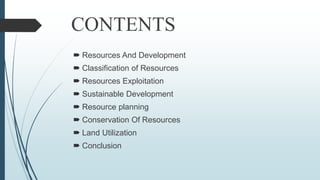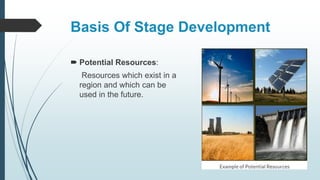Resources and Development
- 2. CONTENTS ’é┤ Resources And Development ’é┤ Classification of Resources ’é┤ Resources Exploitation ’é┤ Sustainable Development ’é┤ Resource planning ’é┤ Conservation Of Resources ’é┤ Land Utilization ’é┤ Conclusion
- 3. Resources And Development ’é┤ Resources: Elements, substances, or features found in the environment that are utilized by living organisms, particularly humans, to satisfy their needs and promote their well-being. These resources are essential for various aspects of human life, from basic survival to economic development and technological advancement.
- 5. ’é┤ Biotic: These are obtained from biosphere and have life such as human beings, flora and fauna, fisheries, livestock etc. ’é┤ Abiotic: All those things which are composed of non-living things are called abiotic resources. For example, rocks and metals. Basis of Origin:
- 6. Basis of Exhaustibility ’é┤ Renewable Resources: The resources which can be renewed or reproduced by physical, chemical or mechanical processes are known as renewable resources.
- 7. ’é┤ Non-Renewable Resources: These occurs over a very long geological time. Minerals and fossil fuels are examples of such resources. These resources take millions of years in their formation.
- 8. Basis of Ownership ’é┤ Individual Resources: These are owned privately by individuals.
- 9. ’é┤ Community: These are resources which are accessible to all the members of the community.
- 10. ’é┤ National resources: Technically all the resources belong to the nation. The country has legal powers to acquire even private property or public good. For example road, canals, railways etc.
- 11. ’é┤ International Resources: The resources like open ocean which do not belong to individual country can be utilised without concurrence of international institutions.
- 12. Basis Of Stage Development ’é┤ Potential Resources: Resources which exist in a region and which can be used in the future.
- 13. ’é┤ Developed Resources: Resources which are surveyed and their quality and quantity have been determined for utilization.
- 14. ’é┤ Stock Resources: Materials in the environment which have the potential to satisfy human needs but human beings do not have the appropriate technology to access these, are included among stock resources.
- 15. Resources Exploitation ’é┤ Depletion of resources for satisfying the greed of few individuals. Accumulation of resources in few hands. Indiscriminate exploitation of resources has led to global ecological crises such as, global warming, ozone layer depletion, environmental pollution and land degradation.
- 16. Sustainable Development ’é┤ Sustainable economic development means ŌĆśdevelopment should take place without damaging the environment and development in the present should not compromise with the needs of the future generations.
- 17. Resource Planning ’é┤ Planning is the widely accepted strategy for judicious use of resources. It has importance in a country like India, which has enormous diversity in the availability of resources. There are regions which are rich in certain types of resources but are deficient in some other resources. There are some regions which can be considered self sufficient in terms of the availability of resources and there are some regions which have acute shortage of some vital resources. This calls for balanced resource planning at the national, state, regional and local levels.
- 18. ’é┤ The availability of resources is a necessary condition for development of any region, but mere availability of resources in the absence of corresponding changes in technology and institutions may hinder development. There are many regions in our country that are rich resources but these are included in economically backward regions. On the contrary there are some regions which have poor resource base but they are economically developed.
- 19. Resource Planning In India ’é┤ Identification and inventory of resources across the regions of the country. This involves surveying, mapping and qualitative estimation and measurement of the resources. Evolving a planning structure endowed with appropriate technology, skill and institutional set up for implementing resource development plans. Matching the resource development plans with overall national development plans.
- 20. Conservation Of Resources ’é┤ Resources are vital for any developmental activity. But irrational consumption and over-utilization of resources may lead to socio-economic and environmental problems. To overcome these problems, resource conservation at various levels is important. Gandhiji was very apt in voicing his concern about resource conservation in these words. ŌĆ£There is enough for everybodyŌĆÖs need and not for any bodyŌĆÖs greed's.ŌĆØ
- 21. Land Utilization ’é┤ Land resources are used for the following purposes: Forests Land not available for cultivation a) Barren and waste land b) Land put to non- agricultural uses. E.g. buildings, roads, factorie.etc. Other uncultivated land (excluding fallow land) a)Permanent pastures and grazing land. b)land under miscellaneous tree crop groves (not included sown area) c)cultural waste land (left uncultivated for more than 5 agriculture years ) Fallow land a) fallow (left without cultivation for one or less than one agriculture years) b)other than current fallow (left uncultivated for the past 1 to 5 agriculture year) 5.Net sown area A sown more than once in an agriculture year plus net sown area as gross cropped area.
- 22. LAND USE PATTERN IN INDIA ’é┤ The use of land is determined both by physical factors such as topography , climate , soil types as well as human factors such as population density, technological capacity and culture and traditional etc. ŌĆó Total geography area of India is 3.28 million sq. km.
- 23. CONCLUSION ’é┤ The importance of natural resources in sustaining life, driving economic growth, and fostering technological advancement cannot be overstated. From the air we breathe to the energy that powers our lives, these resources underpin every facet of human existence. They are the foundation upon which we build our societies, economies, and innovations. ’é┤ However, as weŌĆÖve explored, the unsustainable exploitation of these resources has led to significant challenges, including environmental degradation, resource depletion, and social conflicts. The consequences of such actions are felt by both current and future generations.
- 24. ’é┤ Yet, the path forward is not one of despair, but of opportunity and responsibility. It is a call to action for responsible resource use and conservation. We have the capability to transform our practices, adopt sustainable technologies, and implement policies that prioritize the well-being of both the planet and its inhabitants. ’é┤ By embracing the principles of sustainable management, adopting cleaner energy sources, conserving biodiversity, and respecting indigenous knowledge, we can pave the way for a brighter and more equitable future. This future hinges on our collective commitment to preserve the delicate balance of our ecosystems, safeguard the resources that sustain us, and pass on a thriving planet to the generations that follow. ’é┤ Let us stand united in the pursuit of sustainable development, recognizing that by acting wisely today, we can create a world where prosperity, harmony, and responsible resource management coexist, ensuring a legacy of abundance for generations to come.
- 25. THANK YOU

























